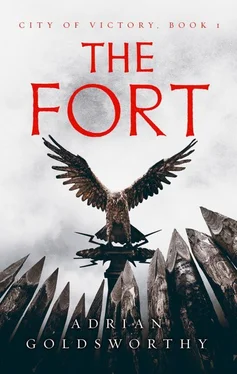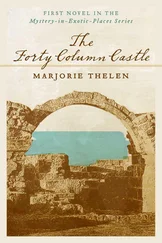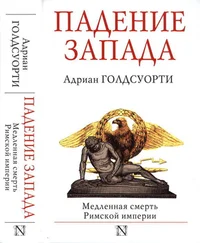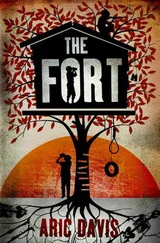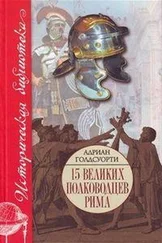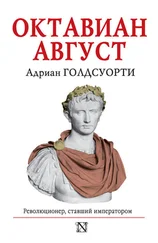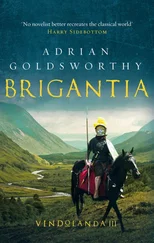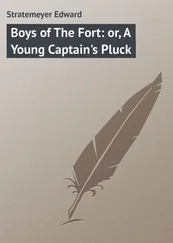In some ways possible if not necessarily likely sums up the whole story. There is so much about the Roman period that scholars simply do not know. When writing a non-fiction history I feel it is my duty to be honest about this. For a novel I try to make the story as accurate as possible, but filling in the many gaps gives me the chance to explore ideas and at times simply use what makes a good story.
ad stercus :literally ‘to the shit’, the expression was used in military duty rosters for men assigned to clean the latrines.
agmen quadratus :literally a square battle-line, this was a formation shaped like a large box and used by a Roman army threatened by attack from any side. Units were deployed to form a rectangle, sheltering baggage and other vulnerable personnel and equipment inside.
ala :a regiment of auxiliary cavalry, roughly the same size as a cohort of infantry. There were two types: ala quingenaria consisting of 512 men divided into 16 turmae ; and ala milliaria consisting of 768 men divided into 24 turmae .
auxilia /auxiliaries:over half of the Roman army was recruited from non-citizens from all over (and even outside) the empire. These served as both infantry and cavalry and gained citizenship at the end of their twenty-five years of service.
Bastarnae:a tribal group living to the east of the Danube. Tacitus, writing a few years before our story, believed them to be akin to the German tribes in terms of language and customs. They had a reputation for bravery.
Batavians:an offshoot of the Germanic Chatti, who fled after a period of civil war, the Batavians settled on what the Romans called the Rhine island in modern Holland. Famous as warriors, their only obligation to the empire was to provide soldiers to serve in Batavian units of the auxilia . Writing around the time of our story, the historian Tacitus described them as ‘like armour and weapons – only used in war’.
belly bow (gastraphetes) :an early type of siege engine, rather like a large crossbow and operated by one man. It was loaded resting the specially curved ends of the staff against the stomach, hence the name.
beneficiarii :were experienced soldiers selected for special duties by the provincial governor. Each carried a staff with an ornate spearhead.
Brigantes:a large tribe or group of tribes occupying much of what would become northern England. Several sub-groups are known, including the Textoverdi and Carvetii (whose name may mean ‘stag people’).
burgus :a small outpost manned by detached troops rather than a formal unit.
caligae :the hobnailed military boots worn by soldiers.
canabae :the civilian settlements which rapidly grew up outside almost every Roman fort. The community had no formal status and was probably under military jurisdiction.
centurion:a grade of officer rather than a specific rank, each legion had some sixty centurions, while each auxiliary cohort had between six and ten. They were highly educated men and were often given posts of great responsibility. While a minority were commissioned after service in the ranks, most were directly commissioned or served only as junior officers before reaching the centurionate.
centurio regionarius :a post attested in the Vindolanda tablets, as well as elsewhere in Britain and other provinces. They appear to have been officers on detached service placed in control of an area. A large body of evidence from Egypt shows them dealing with criminal investigations as well as military and administrative tasks.
clarissima femina : ‘most distinguished woman’ was a title given to women of a senatorial family.
cohort:the principal tactical unit of the legions. The first cohort consisted of 800 men in five double-strength centuries, while cohorts two to ten were composed of 480 men in six centuries of 80. Auxiliaries were either formed in milliary cohorts of 800 or more often quingeniary cohorts of 480. Cohortes equitatae or mixed cohorts added 240 and 120 horsemen respectively. These troopers were paid less and given less expensive mounts than the cavalry of the alae .
colonia :a city with the status of colony of Roman citizens, which had a distinct constitution and followed Roman law. Many were initially founded with a population of discharged soldiers.
commilitones :‘comrades’ or ‘fellow soldiers’.
consilium :the council of officers and other senior advisors routinely employed by a Roman governor or senator to guide him in making decisions.
curator :(i) title given to soldier placed in charge of an outpost such as a burgus who may or may not have held formal rank; (ii) the second in command to a decurion in a cavalry turma .
Dacia/Dacians: a people occupying lands centred on what is today Romania. The Greeks and Romans believed them to be kin to the Getae. They were perceived by the Romans as a significant threat under King Burebista, a rough contemporary of Julius Caesar. The latter was planning a Dacian campaign at the time of his murder. For several generations Dacia appears to have been weakened by internal divisions, until emerging again as a powerful independent kingdom under Decebalus.
decurion:the cavalry equivalent to a centurion, but considered to be junior to them. He commanded a turma .
equestrian:the social class just below the Senate. There were many thousand equestrians ( eques , pl. equites ) in the Roman Empire, compared to six hundred senators, and a good proportion of equestrians were descendants of aristocracies within the provinces. Those serving in the army followed a different career path to senators.
falx :a long, curved sword employed by the Dacians and some of their neighbours. They could be wielded with one or both hands, which gave the blow considerable force. The edge was on the inside of the curve and the pointed tip seems to have been designed to punch through helmet or armour.
frumentarii :soldiers detached from their units with responsibility for supervising the purchase and supply of grain and other foodstuffs to the army.
galearius (pl. galearii) :slaves owned by the army, who wore a helmet and basic uniform and performed service functions, such as caring for transport animals and vehicles.
Getae: were a group of people of similar language and customs (at least to outside observers), living in the wider Balkan area.
gladius :Latin word for sword, which by modern convention specifically refers to the short sword used by all legionaries and most auxiliary infantry. By the end of the first century most blades were less than two feet long.
legate/legatus (legionary):the commander of a legion was a legatus legionis and was a senator at an earlier stage in his career than the provincial governor. He would usually be in his early thirties.
legate/legatus (provincial):the governor of a military province like Britain was a legatus Augusti , the representative of the emperor. He was a distinguished senator and usually at least in his forties.
legion:originally the levy of the entire Roman people summoned to war, legion or legio became the name for the most important unit in the army. In the last decades of the first century BC, legions became permanent with their own numbers and usually names and titles. In AD 98 there were 28 legions, but the total was soon raised to 30.
Читать дальше
